Drone Control: Mastering the Art of Flight
Drone control is an essential skill for anyone looking to navigate the skies with these remarkable flying machines. Whether you are a hobbyist or a professional, understanding the intricacies of drone control can significantly enhance your flying experience. In this article, we will explore the fundamentals of drone control, tips for mastering it, and troubleshooting common issues faced by pilots. Let’s dive into the world of drone flight!
Understanding Drone Control
Before delving into the techniques of drone control, it is crucial to understand what drone control encompasses. At its core, drone control involves managing the drone’s flight path, altitude, speed, and orientation using a remote control or a mobile application. The effectiveness of your drone control largely depends on your understanding of the drone’s components and how they interact during flight.
Components of Drone Control
To master drone control, familiarize yourself with the following components:
- Remote Controller: The primary interface for controlling your drone, featuring joysticks for navigation and buttons for various functions.
- GPS Module: Provides location data, enabling precise positioning and navigation.
- IMU (Inertial Measurement Unit): Sensors that measure the drone’s acceleration and rotation, helping maintain stability.
- Camera and Gimbals: For those interested in aerial photography, understanding how to control the camera is vital.
Step-by-Step Process for Effective Drone Control
Mastering drone control requires practice and knowledge. Here’s a step-by-step guide to help you get started:
Step 1: Familiarize Yourself with the Controls
Take time to understand your remote control layout. Each model may have different configurations, but the basic functions usually include:
- Throttle: Controls the altitude of the drone.
- Yaw: Rotates the drone left or right.
- Pitch: Tilts the drone forward or backward.
- Roll: Moves the drone sideways.
Step 2: Conduct Pre-Flight Checks
Before taking off, ensure your drone is in optimal condition:
- Check battery levels.
- Inspect propellers for damage.
- Ensure firmware is up to date.
- Verify GPS signal strength.
Step 3: Learn to Hover
Hovering is a fundamental skill in drone control. To practice:
- Take off and gradually adjust the throttle to maintain a stable altitude.
- Use yaw to keep the drone facing you.
- Practice holding your position for several minutes to build muscle memory.
Step 4: Practice Basic Maneuvers
Once you are comfortable hovering, it’s time to practice basic maneuvers:
- Forward and Backward Flight: Push the pitch stick forward to move ahead and pull it back to reverse.
- Sideways Movement: Use the roll stick to move left or right.
- Yaw Control: Rotate your drone by adjusting the yaw stick.
Step 5: Experiment with Advanced Techniques
Once you’ve mastered basic controls, explore more advanced techniques:
- Waypoint Navigation: Use GPS to set predefined flight paths.
- Follow Me Mode: Allow the drone to autonomously follow you.
- Aerial Photography: Learn to control the camera and gimbal for stunning shots.
Troubleshooting Common Drone Control Issues
Even experienced drone pilots encounter issues. Here are some common problems and how to solve them:
Lost Signal
If you lose connection with your drone:
- Check for obstacles that may interfere with the signal.
- Ensure you are within the operational range.
- Use the return-to-home feature if available.
Unstable Flight
For drones that drift or wobble:
- Calibrate the IMU before every flight.
- Check for wind conditions that may affect stability.
- Inspect and tighten any loose components.
Battery Issues
If your drone is not holding a charge:
- Check battery health and replace if necessary.
- Ensure you are using the correct charger.
- Store batteries properly to extend their lifespan.
Conclusion: Elevating Your Drone Control Skills
Mastering drone control is a journey that combines knowledge, practice, and patience. By understanding the controls, practicing essential maneuvers, and troubleshooting issues, you can significantly enhance your flying experience. Remember, every flight is an opportunity to learn and improve your skills. For more resources on drone flying, check out this guide.
As you embark on your drone flying adventures, always adhere to local regulations and guidelines to ensure a safe and enjoyable experience. With dedication and practice, you’ll unlock the secrets of flight and become proficient in drone control!
For further reading on advanced drone techniques, visit this external resource to enhance your knowledge and skills.
This article is in the category Technology and created by DroneNexus Team
